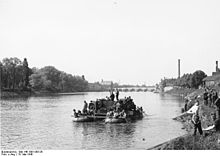Battle of Maastricht
Maastricht was a key city in order to capture the Belgian Fort Eben-Emael and split the allied armies in half.
The German goal of the operation was to take the bridges over the river Maas intact, to have an easier road to France.
In the early morning hours, a patrol of six motorised infantrymen approached the eastern guard post.
The Dutch let them approach to within 50 m (55 yd), then opened fire with two machine guns and every rifle available.
The men at the sluice itself were able to resist the Germans, but the southeastern squad—which defended the northern entrance into Maastricht—had to give in when their machine gun failed.
The gap that now existed in the outer defences of the city was soon penetrated by the majority of the Germans that had agitated against the sluice.
The defending unit was ordered to move back behind the Maas once it become clear that the outer defences had been penetrated.
When the German infantry had almost reached its position the commanding Dutch sergeant ordered an organised retreat.
The Germans felt that it could be a very useful crossing point for tanks, and only 35 Dutch soldiers defended it.
After all of the bridges over the Maas River were destroyed, the only task that remained was to hold off the Germans as long as possible.
When the Germans boldly placed an anti-tank gun in front of the bridge, aimed at the adjacent St. Servaasbrug, the Dutch instantly killed the crew.
A small number of rubber boats tried to cross the Maas but were shot to pieces.
Luitenant-Kolonel Govers, Territorial Commander (TC) of Limburg, had called a meeting later in the day.
The outcome of the meeting was that all further opposition to the Germans in and around Maastricht, the last standing defences in Limburg, would cease.
